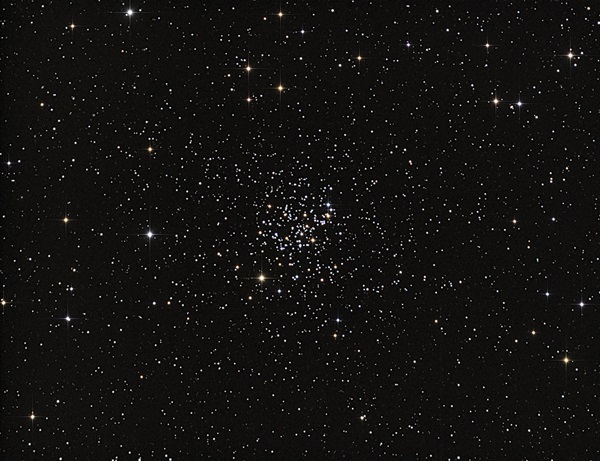Key Takeaways:
- The constellation Cancer is faint, with its brightest star, Beta Cancri, having a magnitude of 3.5, making observation challenging even without light pollution.
- The Beehive Cluster (M44) in Cancer is a prominent open cluster, spanning 1.5 degrees and containing potentially over 1000 stars, though mostly visible as 75 white spectral type A stars with a few red or orange stars visible with binoculars.
- Iota Cancri is a challenging binary star system within Cancer, consisting of a yellowish 4th-magnitude primary and a bluish 7th-magnitude companion, requiring high-powered binoculars for resolution.
- M67, another open cluster in Cancer, is fainter than M44, containing approximately 200 stars, none brighter than 10th magnitude, and is noteworthy for its age and location far from the Milky Way's plane.
One of the faintest figures lying along the ecliptic, Cancer the Crab often confounds naked-eye constellation hunters in search of new conquests. Even without the extinguishing effect of light pollution, the Crab’s stars are just above the limit for most observers.
The Crab’s body is drawn from four stars in a trapezoid, while its legs extend north and south. The brightest of the bunch, Beta (β) Cancri, shines at only magnitude 3.5; the rest are fainter.
Binoculars prove helpful to identify the Crab’s stars. Aim about halfway between Castor and Pollux, in Gemini, and Regulus, in Leo. There, keep an eye out for the Crab’s trapezoidal body. The stars Asellus Borealis (Gamma [γ] Cancri) and Asellus Australis (Delta [δ] Cancri) bound the eastern side; Eta (η) and Theta (θ) Cancri form the western boundary.
Look closely at the colors of the four stars. See any differences? Slightly defocusing them will accentuate the effect. Delta, Theta, and Eta are all spectral type K orange giant stars, larger but cooler than our Sun. The fourth, Gamma, is a type A white subgiant, making it both larger and hotter than the Sun.
These four stars nicely frame one of the finest binocular targets found anywhere in the sky. The Beehive Cluster (M44) is a striking sight at low magnification. Also nicknamed Praesepe, which is Latin for “manger,” M44 comes alive in sparkling style through just about any binocular, no matter how large or small, expensive or affordable. That’s partly because of the cluster’s wide berth. M44 spans 1.5°, or three Full Moons stacked end to end. Telescopic fields are just too narrow.
How many stars actually belong to M44 is open to debate. A 2007 survey published in The Astronomical Journal said the true number may exceed 1,000. Part of the confusion surrounds the number of faint red dwarfs lying within. That analysis suggests there could be more than 650.
Of course, we can’t hope to see those through binoculars. Most of the 75 or so that we do see are white spectral type A stars. At least four, however, glisten with contrasting tints of red or orange. Again, defocusing a little heightens color saturation.
Many stars in M44 align in interesting pairs or patterns. For instance, five centrally located in the cluster form a V that my eye interprets as either an arrowhead or even a miniaturized version of Taurus the Bull’s head.
Look carefully, and you’ll see that one of the stars in the V is actually a triple. Cataloged as Burnham 584, the three stars are separated by 45″ and 93″, respectively.
While Charles Messier added it to his growing catalog of faint fuzzies in 1769, the Beehive was known long before the invention of the telescope. The first person to note it was the Greek poet-turned-astronomer Aratus. He referred to M44 as Achlus, meaning “Little Mist,” in his poem about the sky, Phainomaina (Heavenly Displays) in the third century b.c. The true nature of Praesepe didn’t come to light until Galileo viewed it through his first crude telescope nearly two millennia later.
Let’s use M44 as a jumping-off point for two more targets hidden in the Crab. First, hop 9°, or about 1.5 binocular fields, due north to Iota (ι) Cancri. Whereas M44 is an easy target, this one will prove a challenge — not in finding the star, but in resolving it, because Iota is a binary system. Here, a yellowish, 4th-magnitude primary star is accompanied by a bluish, 7th-magnitude companion separated by just 31″. That’s doable in steadily supported 8x binoculars, but it takes a sharp eye and steady seeing conditions to pull it off. I can make it out in my 10x50s, but again only if they are secured to a base. With more oomph, my 16x70s and, especially, my 25x100s display Iota as one of the prettiest binaries in the northern spring sky.
Return to M44, but only briefly on your way to one of the Crab’s claws, Acubens. Can you see a fuzzy blur less than 2° to the star’s west? That’s Cancer’s second contribution to the Messier catalog, M67. It may not stand out as well as M44, but M67 is still bright enough to be seen through my 7x35s as my own “Littler Mist,” even with suburban light pollution. Since none of its 200 stars shines brighter than 10th magnitude, however, we have little hope at resolving them through most binoculars. One or two faint points may just squeak out using averted vision.
M67’s location far from the plane of the Milky Way makes it especially interesting to study. Normally, open star clusters are found along the plane, where gravity from other stars causes them to disperse in a matter of a few million years. But M67 is situated away from such influences. As a result, it has outlasted nearly every other open cluster in the Milky Way. From studying its stars, we know M67 is between 3.2 billion and 5 billion years old.
Next month, we go dipper diving. Until then, don’t forget that two eyes are better than one!













